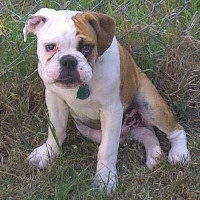Appearance of the Valley Bulldog
|
| Valley Bulldogs are hardy dogs originally bred from the Boxer and English Bulldog. Depending on the parent from which the dog derives most of its physical traits, this attractive dog may resemble a large English Bulldog or a shorter version of the Boxer. The Valley Bulldog has strong, broad shoulders and a large head. The neck is thick and solid, and the chest is muscular. Interestingly, it can have two nose shapes: either a long muzzle, or one that is described as tucked-in. Ears are generally short and may have a slight fold. With a small tail that is sometimes naturally developed as if docked, these dogs also have a robust hindquarters that is supported by strong legs. Colors usually seen are tan, fawn, red, white and brindle. Some Valley Bulldogs have an underbite. All dogs of this breed have strong jaws and often give the impression of having a smile on their face. |
Temperament of the Valley Bulldog
|
| The Valley Bulldog is a very gentle breed, with a kind, gentle and willing temperament. They are perfect for owners who can take on the role of pack leader, and once properly trained and socialized, these dogs can be excellent companions for humans of all ages, as well as other dogs and pets. The Valley Bulldog's wonderful personality will bring joy to the whole family, as its calm, gentle nature can quickly turn to playfulness and goofiness. These dogs are affectionate and love nothing more than to be in the company of their beloved masters. They love to please and can easily be trained and taught tricks. Valley Bulldogs also make excellent watchdogs, alerting you to unfamiliar noises or people. These gentle dogs absolutely need a dominant master who's equal to their strength, and who gives them rules and a person to follow. |
Needs and activities of the Valley Bulldog
|
| These dogs can be prone to obesity and need sufficient exercise, as well as a controlled diet. Valley Bulldogs need daily exercise and can even be quite athletic, thanks to their Boxer heritage. However, these dogs are also related to the English Bulldog and can sometimes be clumsy. They love to run free in a large space, so access to a safe enclosed area is a must. They love to play with toys, but can chew through almost anything with their strong jaws. So be sure to buy highly durable chew toys that can withstand the Valley Bulldog's mischievousness. As these dogs are not a particularly large breed, they don't need to live in a huge house. A medium- to small-sized home is usually sufficient for this breed to get around, provided they have access to the outdoors and can get enough exercise to keep fit. The Valley Bulldog can be uncomfortable in both heat and cold, and should not be left outside in extreme weather or exercised excessively in the heat. |
Maintenance of the Valley Bulldog
|
| These dogs are fairly easy to care for, although the skin folds on their face, body and tail may require special attention. To keep your Valley Bulldog in good health, you need to make sure these areas are always dry and clean, otherwise they risk becoming infected. This should be a quick task, but will need to be done daily. These dogs have soft coats and short coats that are easy to care for. As this breed has a moderate shedding rate, only occasional brushing is needed, and baths are rarely necessary. The Valley Bulldog's other needs include teeth brushing, which should ideally be carried out daily, although 3 times a week is sufficient. Nails should be trimmed if necessary, usually twice a month, depending on the dog's activity. It's also important to clean your dog's ears at least once a week to prevent ear infections. As with all dogs, it's advisable to teach your dog the basics of obedience when he's still a puppy, in order to raise a calm, respectful animal. |







 English (United Kingdom)
English (United Kingdom)